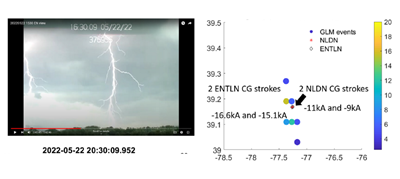CISESS Lightning Camera Network Seed Grant Results

Screenshot of lightning with 1/100th second time-resoluton taken by the Raspberry Pi camera network on May 5, 2022. Bottom: The colored dots are the GLM pixel geolocations, color-coded by energy in femtojoules.
© Daile Zhang
Building & Deploying Tools to Better Observe Lightning in the Washington D.C. Region & Beyond
A regional network Mid-Atlantic Lightning Mapping Array (MALMA), run and maintained by the CISESS/UMD lightning research team, has gone through many repairs, upgrades, relocation, and other maintenance activities in the recent few years. Initial result show that the MALMA network now has a higher lightning detection efficiency compared to the old network. It is necessary to reevaluate the upgraded network with some ground-truth data. The goal of this project is to collect the validation data by creating a network of low-cost and innovative atmospheric electricity and lightning measurement tools to take lightning videos. This data can also be used to validate the Geostationary Lightning Mappers (GLMs) on the NOAA’s GOES-16 and -17 satellites and to better understand lightning events.
CISESS Scientist Daile Zhang, with the help of her student interns Dominic Brooks, Alex Friedman and Samantha Smith, has designed and built a Raspberry Pi camera network for high-speed lightning video observation. Each Raspberry Pi camera set includes a Raspberry Pi board, which is a small single-board Linux computer, a high-quality Pi camera module with a wide-angle lens, a tripod, a monitor, a keyboard, and a mouse. The Pi cameras take high-speed videos (~90 fps) depending on the situations with each frame time-stamped with GPS location information (see Figure below). Four Raspberry Pi Cameras were set up in Maryland. Surprisingly, many people showed interest and were willing to host a site at their local offices/residences after the start of the project. Therefore, they were able to deploy additional two cameras in Arizona and one in Oklahoma for their future field campaign testing purposes.
For each stroke identified in the network video, the time and frame number were collected in a spreadsheet along with time, geolocation, optical energy, altitude amd other relevant parameters. The time and estimated location were used to find whether there were any GLM or MALMA detections. Below is the detection data for the double lightning strike show above. Overall, more than 30 active days from different locations were collected and at least 10 days of data have been carefully examined. In total, 61 flashes and 195 strokes were analyzed.
This project has continued beyond the initial Seed Grant period and, as of June 2023,there are 16 Raspbery Pi cameras in operation in Maryland (6), North Carolina (2), Oklahoma (1), Colorado (2), and Arizona (5).
« Back